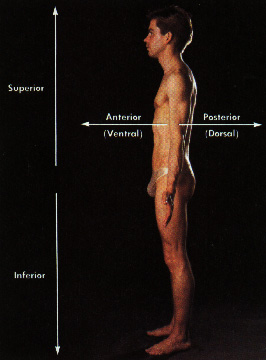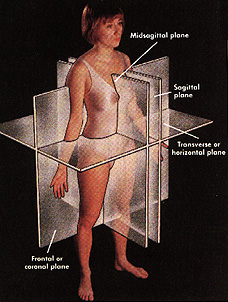Relative Position
Terms of relative position are used to describe the location of one body part with respect to another. They include the following:
 |
1. Superior (or Cranial): a body part is located above another part or closer to the head. (The oral cavity is superior to the thoracic cavity.) 2. Inferior (or Caudal): a body part is located below another body part or toward the feet. (The nose is inferior to the forehead.) 3. Anterior (or Ventral): relates to being toward the front of the body. (The breasts are anterior to the shoulder blade.) 4. Posterior (or Dorsal): the opposite of anterior; it means toward the back. (The esophogus is posterior to the trachea.) |
 |
5. Medial: An imaginary midline divides the body into equal right and left halves. A body part is medial if it is closer to this line than another part. (The nose is medial to the eyes.) 6. Lateral: means toward the side relative to the imaginary midline. (The ears are lateral to the eyes.) 7. Proximal: describes a body part that is closer to a point of attachment or closer to the trunk of the body than another part. (The elbow is proximal to the wrist.) 8. Distal: the opposite of proximal. It means that a particular body part is farther from the point of attachment or farther from the trunk than another part. (The fingers are distal to the wrist.) |
10. Deep:
is used to describe parts that are more internal. (The dermis
is the deep layer of the skin.)
To better understand and observe the locations
and arrangements of the internal parts, it is necessary to cut
or section the body along various planes. The following terms
are used to describe such planes and sections:
1. Sagittal:
a lengthwise cut that divides the body into right and left portions.
If a sagittal section passes along the midline, dividing the
body into equal parts, it is called median (midsagittal). 2. Transverse:
(or horizontal) a cut that divides the body into superior and
inferior portions (upper and lower). 3. Frontal:
(or coronal) a section that divides the body into anterior and
posterior portions (front and back).
Sometimes a cylindrical structure such as blood
vessel is sectioned. In this case, a cut across the structure
is called a cross section, an angular cut is an oblique
section, and lengthwise cut is a longitudinal section.
Take the Anatomical
Direction Test
Page created on 8/28/97. Thanks Jennifer!
Body Sections
